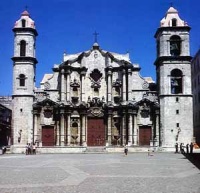5.3 Religious music in Cuba in the 17th century.

During this period, the Cathedral of Santiago de Cuba (Heredia between San Félix and Santo Tomás, Santiago de Cuba) was experiencing musical decline. Every effort was made to find a faithful organist, as during these years religious services began to lack the solemnity of the organ due to a lack of trained personnel to play it. The choir consisted of two assisted cantors, and on certain festivals, black female singers and a local instrumentalist. A truly serious defect of the period in the cathedral was that the choir lacked plainchant books for its management. The field choirmaster, Don Álvaro de la Raspudia, was responsible for obtaining the necessary books from Mexico.
Bayamo was the island’s second-largest town, due to its population density, livestock, and the trade of cattle and hides, among other products; almost all of this was smuggled. The town benefited from its religious music. According to contemporary witnesses such as that of Vicente Balboa, the religious ceremonies held in Bayamo were particularly brilliant compared to those in Santiago de Cuba.
Religious music also flourished in the Church of San Cristóbal de La Habana, whose masonry construction began in 1550. An organ was installed there in 1612; at that time, greater attention was paid to the majesty of religious services. Years later, to maintain the level of the ceremonies, trained singers were required. The Colegio de San Ambrosio (San Ignacio between Tejadillo and Empedrado, Old Havana, Havana City) was established to educate twelve children who would serve at the altar and in the choir of the Main Parish Church.








